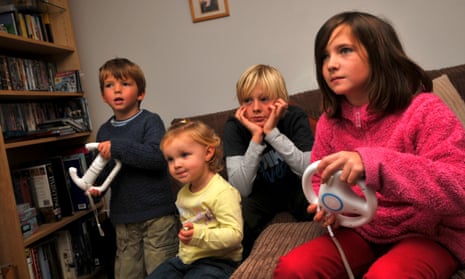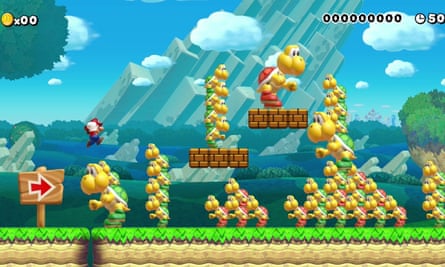
Children and video games: a parent's guide
Pro tips on which games your child should play, how long they should play for, how to limit screen time – and what to do if their friend plays violent games
For me, parenting often feels like endlessly having to say no. No, we can’t have Kinder Eggs for breakfast. No, we can’t buy a horse. No, it doesn’t matter that you only met her once, you still can’t wear swimming trunks to Auntie Ethel’s funeral. Although that last one was my husband.
Now my eldest son is six, and has discovered video games, there’s a new no to add to the list: no, we can’t sit around playing Crash Bandicoot in our pants all day. Even though this is basically how I spent the whole of the 90s, and it’s what I’d be doing now if I didn’t have two small children.
I do manage to get some gaming in, thanks largely to the fact it’s part of my job. I write about games for a living, and also appear as the games expert on TV show Dara O Briain’s Go 8 Bit. So I can tell you all sorts of fun facts about when Space Invaders was invented and why Mario has a moustache.
I’m less confident when it comes to parenting – I may be able to speed-run the first level of Sonic the Hedgehog in under 45 seconds, but I have yet to get a small child to put his shoes on in less than 25 minutes. Nevertheless, other parents often ask me about managing their kids’ gaming. It’s the question I most hear at the school gates, apart from, “Didn’t you know it’s World Book Day?” and, “Is that wine on your trousers?” So for what it’s worth, here are my top tips.
‘What games should my child be playing?’
Like films, all video games carry age ratings, and it’s worth paying attention to these. If you wouldn’t let your child watch an 18-rated film, they shouldn’t be playing an 18-rated game. Fortunately, it’s a myth that all games are about shooting stuff. There are 18,000 titles on Amazon with an age rating of 3+. Some of them are even good.
What would I recommend? Well, you might want to look out for games that encourage kids to create, such as Minecraft, LittleBigPlanet, Lego Worlds or Super Mario Maker. They get to use their imaginations, and you get to feel slightly less guilty that they’re not playing the violin and learning fractions. If you have a tablet, Toca Boca makes beautiful, interesting games for young children that won’t have you crying with boredom within 30 seconds.

PRO TIP: If you’re a lapsed gamer, consider introducing your child to some of your old favourites – that way you can have a nostalgic chat, and also beat them. These days there are swish remakes of classics like Ratchet & Clank and Crash Bandicoot, plus new instalments in fondly remembered series such as Legend of Zelda and Mario Kart. Don’t bother with the original games; they’re all horribly difficult and look like they’re made of Ceefax.
Alternatively, try and find kid-friendly versions of the games you enjoy playing anyway. If you love Grand Theft Auto, try Lego City Undercover; if you’re a fan of Doom, introduce your kids to Splatoon. This way they may be able to turn pro by the time they’re 13, guaranteeing you a handsome retirement fund.
‘How long should my child play for?’
Ideally, my kids would spend their days building rafts out of foraged driftwood and catching trout while laughing gaily in the sunshine. Unfortunately, we live in the real world. Catford, to be specific. Also, they hate that stuff.
I do make sure they spend time outdoors, and enjoy other good things like reading books, attending music lessons and constructing elaborate weapons out of old cornflake boxes. But I also allow them to play video games, because kids need downtime. It’s about balance – I don’t let them play games all day, just like I don’t let them eat Kinder Eggs for every meal. Unless it’s Easter. Or we’ve run out of fish fingers.
PRO TIP: There are no official UK guidelines on screen time. The American Academy of Paediatrics recommends no screen time at all for children under the age of 18 months, followed by a maximum of one hour a day up to the age of five. There’s no suggested number of hours for children aged six and up, but, you know, doing anything for more than a few hours a day is probably not a good idea – 90 mins is often bandied around as a sensible upper limit.
There is, however, a lot of complicated research into this subject, which tends to get inaccurately reported – often when the tabloid press has run out of stories about Kim Kardashian. Earlier this year, a group of scientists wrote an open letter asking for screen time advice to be based on actual evidence, and that playing games is not inherently harmful. And who am I to argue with scientists?
‘What’s the best way to drag kids away from a screen?’
It can be easier to get kids off their consoles if you agree a time limit at the start of the session. Give them a five minute warning before the time is up, so they have a chance to save their progress. Be firm, but reasonable; if they really do need just one more minute to finish the match or beat the boss, show magnanimity. Hell hath no fury like a child whose mum pulls the plug just as they’re about to finally defeat the Blargian Snagglebeast. The nuclear option is to tell them that every minute they spend playing after the time limit expires will cost them five minutes of their next session. This may end up requiring a spreadsheet and a calculator.
PRO TIP: For younger kids, use a kitchen timer to set the agreed limit and place it somewhere they can see it (not reach it – they may be unable to tell the time, but they aren’t dumb.)
‘What do you do if their friend plays Grand Theft Auto V?’

Managing your child’s exposure to games at other people’s houses can be trickier than evading the cops after you’ve robbed a Rockford Hills jewellery store and run over a pimp. It’s a social minefield: how do you tell another parent you don’t think your kid should be playing games that their child is allowed to play, without making them feel like you’re judging them, which you are?
It’s best to be honest, but not too honest. Put the emphasis on your child - explain you’re concerned about how mature they are, how easily influenced they might be, whether they’re developmentally ready to see a Nazi zombie battered to death with a rusty pipe, and so on. Chances are the other parent will be sympathetic, and will wait till you’re out of earshot to laugh at your lily-livered Guardian reader sensibilities.
PRO TIP: There is a lack of conclusive evidence about the link between video games and violent behaviour, and lots of debate. A small amount of exposure is unlikely to turn your child into a homicidal maniac. The important thing is to maintain an open, honest exchange of dialogue. Or if you have teenagers, just do your best to interpret the eye-rolls.
Conclusion
As with most aspects of parenting, managing your kids’ gaming comes down to a combination of making informed, considered decisions, and making it up as you go along. Arm yourself with facts - get to know the Pegi ratings system, and learn how to use your console’s parental controls (the Xbox One, PS4 and Nintendo Switch all have them, as do tablets and phones – the InternetMatters site has a handy guide). You know your child better than anyone else, so trust your instincts when it comes to what’s right for them.
Most importantly, remember that video games are brilliant, and can be great for children. They can teach us how to create, how to play, and how to lose. They are thrilling, inspiring, scary, beautiful and hilarious, sometimes all at the same time. Most of all, they are fun. And both kids and grownups could use some of that these days.



